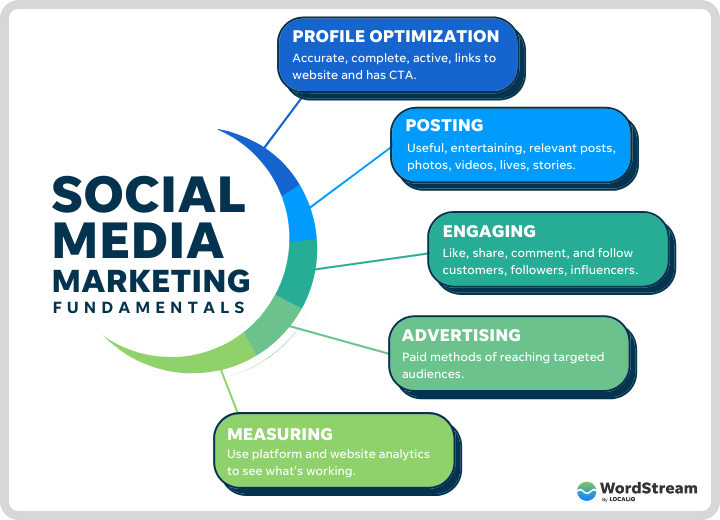Lecture 2: Advanced Digital Marketing Strategies
✨ Master the Art of SEO & Social Media Marketing
🎓 Presented By: M. Yaseen Rashid
🚀 Elevate Your Online Presence with Proven Techniques
Topic 1: SEO (Search Engine Optimization) - Detailed English Briefing
1. What is SEO?
SEO stands for "Search Engine Optimization," which means optimizing your website so that when people search on Google or other search engines, your website appears on the top pages. It's about improving your site's visibility for relevant searches.

(Placeholder image: This would be replaced with a real infographic/image explaining SEO)
How SEO Works?
Search engines (like Google) send their Crawlers or Spiders to scan websites, understand them, and store them in their database. Algorithms then decide which result is the most relevant and authoritative to display at the top for a given query.
Importance of SEO:
- Free Traffic to your website: Organic search results drive highly qualified visitors without direct ad costs.
- Builds Branding and Trust: High rankings signal authority and credibility, building consumer trust.
- Provides Long-Term Growth: Once established, SEO efforts continue to yield results over time, providing sustainable growth.
- Best low-cost marketing method: Compared to paid advertising, SEO offers an excellent return on investment in the long run.
2. Types of SEO:
SEO is broadly categorized into three main types:
📅 On-Page SEO:
The work done inside the website to optimize individual web pages for higher ranking and to earn relevant traffic.
- Title Tags: Unique, concise title for each page, telling Google what the page is about.
- Meta Description: A short, compelling summary of the page, displayed in Google search results beneath the title.
- Headings (H1, H2, H3): Structuring and organizing page content logically with relevant keywords.
- Keyword Optimization: Strategically using keywords in the correct places within your content, but naturally.
- Keyword Stuffing: Incorrect practice of using the same keyword repeatedly, which can lower your Google ranking and harm user experience.
- Image Alt Text: Naming images with descriptive text to help search engines understand their content and for accessibility.
- Internal Linking: Linking to other relevant pages within the same website to improve navigation and distribute link equity.
📅 Off-Page SEO:
External strategies outside the website that aim to improve the popularity, relevance, trustworthiness, and authority of your domain.
- Backlinking: Obtaining high-quality links from other reputable websites to yours, signaling authority.
- Social Media Signals: Indirectly influencing SEO through likes, shares, and mentions on platforms like Facebook and Instagram, increasing visibility.
- Influencer Marketing: Promoting your website or content through influential individuals to gain exposure and potential backlinks.
📅 Technical SEO:
Fixing the technical settings of the website to help search engine crawlers efficiently crawl, index, and rank your site.
- Site Speed: Ensuring fast website loading times, which is a critical ranking factor and user experience element.
- Mobile Responsiveness: Ensuring your website displays and functions well on all mobile devices.
- Structured Data (Schema Markup): Special coding that tells Google exactly what the page content is about, enabling rich snippets in search results. Example: Product reviews, prices, star ratings.
- URL Structure: URLs should be simple, short, descriptive, and clean for both users and search engines.
- Sitemap: An XML file that lists all important pages on your website, helping Google understand the website structure and index content.
3. SEO Tools:
Essential tools to monitor, analyze, and improve your SEO performance:
- Google Search Console: Free tool by Google to check website ranking, indexing status, and identify errors.
- Google Analytics: Free tool by Google to understand website traffic, user behavior, and conversion tracking.
- SEMrush, Ahrefs, Moz: Premium tools for comprehensive backlink checking, in-depth keyword research, competitor analysis, and site audits.
4. SEO Best Practices:
Implement these strategies for effective SEO:
- Perform proper keyword research: Understand what your target audience is searching for.
- Use long-tail keywords (long and specific phrases): These have low competition but attract very targeted traffic.
- Write high-quality content: Provide valuable, relevant, and engaging content that answers user queries.
- Make your website mobile-friendly: Essential for ranking and user experience given the prevalence of mobile Browse.
- Obtain high-quality backlinks: Focus on earning links from authoritative and relevant websites.
Long-Tail Keywords:
These are keywords with 3 or more words, having low competition but very targeted traffic. E.g., "best budget smartphone for students 2025".
Short-Tail Keywords:
These are 1-2 word keywords, with high competition. E.g., "smartphone".
Keyword Stuffing:
The wrong practice of repeating keywords excessively, which can harm your ranking and lead to penalties from search engines.
5. SEO Case Studies:
Real-world examples demonstrating the impact of SEO:
- A local business increased its traffic by optimizing Google My Business and Local SEO: This involved optimizing their Google Business Profile and building local citations.
- An eCommerce website increased sales by optimizing product pages: This included using specific product keywords, rich snippets, and high-quality product descriptions.
6. SEO Performance Measurement:
How to track and evaluate the success of your SEO efforts:
- Track organic traffic: Monitor the number of visitors coming to your site from search engines.
- Use Google Search Console and Google Analytics: These tools provide detailed insights into your site's performance in search and user behavior.
Topic 2: Social Media Marketing (SMM) - Detailed English Briefing
1. What is SMM?
Social Media Marketing means using social media platforms to promote your product or brand. It involves creating and sharing content, running ads, and engaging with your audience to achieve marketing and business goals.

(Placeholder image: This would be replaced with a real infographic/image explaining SMM)
Importance:
- Direct customer reach: Engage with your audience directly and build a community.
- Builds brand awareness: Increase visibility and recognition for your brand.
- Increases sales and leads: Drive traffic, conversions, and generate new business opportunities.
Platforms:
Key social media platforms for marketing:
- TikTok
- Twitter (now X)
2. SMM Strategies:
Develop a comprehensive strategy for social media success:
Goals:
- Awareness: Making the brand famous and increasing its visibility.
- Engagement: Encouraging interactions like Likes, Comments, Shares, and saving posts.
- Conversion: Driving specific actions like Sales, Sign-ups, or website visits.
Target Audience:
Precisely define your audience for effective targeting:
- Specify Age, Gender, Interests, Location.
Platform Specific Strategy:
Tailor your approach for each platform:
- Facebook vs Instagram Ads: Different ad formats and audience behaviors.
- TikTok campaign trends: Leverage trending sounds and challenges.
- LinkedIn for B2B Marketing: Focus on professional networking and industry content.
Content Creation:
Develop engaging content for your audience:
- Create images, videos, infographics: Visually appealing and informative content.
- Write attractive captions: Compelling text that encourages action.
- Gain engagement through polls and Q&As: Foster interaction and gather insights.
3. Paid vs Organic Social Media:
Understanding the two main approaches to social media presence:
- Organic: Free growth through consistent posting, community engagement, and viral content.
- Paid: Targeting specific audiences through paid ads, offering faster reach and precise control over campaigns.
4. Social Media Analytics:
Monitor and analyze your social media performance:
- Track performance using Facebook Insights, Instagram Analytics, and Google Analytics. These tools provide data on reach, engagement, demographics, and conversions.
5. Influencer Marketing:
Collaborate with influencers to reach new audiences:
Influencer Types:
- Micro Influencers: Typically 5,000 to 100,000 followers, known for high engagement rates and niche audiences.
- Macro Influencers: Hundreds of thousands or millions of followers, offering broad reach but generally lower engagement rates compared to micro-influencers.
Choosing the Right Influencer:
- Check relevance: Ensure their content aligns with your brand.
- Engagement rate: Prioritize influencers with active and engaged followers.
- Audience match: Verify their audience demographics match your target market.
6. Successful Campaign Examples:
Inspirational examples of successful social media campaigns:
- Viral campaigns on TikTok: Brands leveraging trends and user-generated content for massive reach.
- Cross-platform campaigns by brands like Nike and Coca-Cola: Integrated strategies across multiple platforms for consistent messaging and wider impact.
Additional Practical Sessions:
- SEO Practical: Show live optimization of title, meta description on a website.
- SMM Practical: Show live Facebook post creation and ad boosting process.
Students Assignment:
- SEO Assignment: Conduct keyword research, write a blog, and perform on-page SEO.
- SMM Assignment: Create a social media post and develop an ad targeting strategy.
Ready to Master Advanced Digital Marketing?
Enroll in YR Tech Growth's comprehensive program and unlock your potential in SEO and Social Media Marketing.
Start Your Journey to Digital Success